Ijraset Journal For Research in Applied Science and Engineering Technology
- Home / Ijraset
- On This Page
- Abstract
- Introduction
- Conclusion
- References
- Copyright
Deep Learning-Based Pre- trained Model for Classification and Detection of Potato Leaf Disease
Authors: Niharika Sharma, Jaimala Jha
DOI Link: https://doi.org/10.22214/ijraset.2024.65633
Certificate: View Certificate
Abstract
From the Holocene period of the earth, formation of physical geography has started and the flaura\'s and faunna\'s had played a very huge role in supplementing to the earth. Apart from the whole earth India is the country that contributed about 7.68% of total world\'s farming output. The potatoes is an essential food crop worldwide, feeding billions of individuals. Nevertheless, the presence of different diseases has a significant impact on potato production and quality, resulting in substantial financial losses for farmers and potential concerns regarding food security. Detecting these diseases accurately and early on is vital for implementing effective strategies to manage them. In recent times, Convolutional Neural Networks (CNNs), a type of deep learning technique, have shown remarkable success in recognizing various objects in images. This work investigates the use of CNNs to identify diseases in potato leaves, aiming to aid in prompt disease diagnosis and protect crops.
Introduction
I. INTRODUCTION
Potatoes are a crucial crop for global food security and most adaptable crop, accounting for roughly 28.9% of total rural harvest creation in India. Potatoes are the world's fourth most important rural food crop. With an annual production of 48.5 million tonnes. Mainly rich in potassium, vitamin C, vitamin B6, and fibres are all abundant in potatoes. Also helps in treating heart disease, coronary sickness, and disease by lowering the overall level of blood cholesterol. India is the second largest potato grower in the world, but they face significant threats from diseases like late blight, early blight, blackleg, and viral infections such as Potato Virus Y (PVY). These diseases can cause considerable economic losses, reduce crop quality, and increase reliance on pesticides. Timely detection and precise classification of potato diseases are essential for effective disease management strategies. Conventional methods of identifying diseases rely on visual inspections by trained experts, which are subjective, time-consuming, and prone to errors. The rapid spread of diseases and their complex symptom manifestation make it difficult for farmers to respond promptly. Therefore, there is an urgent need for automated systems that can recognize diseases in real-time, enabling proactive disease management. Deep learning techniques, particularly Convolutional Neural Networks (CNNs), have shown impressive results in various computer vision tasks, including image recognition. Building upon the capabilities of CNNs, this research proposes an innovative approach for automated disease recognition in potato leaves. The goal is to develop an efficient and accurate solution that can assist farmers in identifying and managing potato diseases effectively. The main purpose of this research is to identify the leaf which is diagnosed with early blight and late blight using CNN. In the above diagram the pictures are shown of healthy potato leaf ,early blight and late blight.
II. EXISTING LITERATURE CONTENT
Research in the plant disease detection has various dimensions and there are various studies also which is previously done in the past . some of them discussed in this section .
U. Kumari et. al.[1] divided many aspects of a picture , including variance, connectivity, power, uniformity, average, standard deviation and volatility , among others using an image segmentation approach . Aakansha Rastoge et. al. [2] also done a study using Artificial Neural Network and Fuzzy Logic to detect disease in plants leaf . This study is on Maple and Hydrangea leaves . in this study the disease are namely leaf spot and scorch leaf leaf spot is a kind of spot in the leaf and in scorch leaf disease is spread all over the leaf . Prajwala et al.[3] uses LeNet architecture model in this research, Convolutional Neural Network to detect disease such as septoria leaf spot and yellow leaf Curl in tomato leaf. The accuracy is 94-95% of this research. Rizqui Amaliatus et al.[4] uses VGG Network, VGG16 and VGG19 for image classification of potato leaf and data augmentation to produce more robust system with research accuracy of 91%.
Divyansh et. al. [5] used concept of transfer learning and have developed an automated system to detect and classify disease in potato leaves like early blight, late blight and healthy leaf using VGG19 model with accuracy of 97.8% in this research . Anjna et. al. [6] uses Support Vector Machine Classifier to detect diseased capsicum. In this work first segmentation is perform to find out the affected part then feature extraction technique is done to extract features and lastly classification is done using SVM Classifier . The disease namely anthracnose leaf, bacterial spot , powdery mildew, cercospora leaf spot and gray leaf spot. Mr. Girish Athanikar et. al.[7] uses Neural Network Model for classification of leafs . In this research a total of 150 images of potato leaf samples are used . BPN feed forward Neural Network is used for training, learning , testing, detecting and classifying the leaf types. V. Veerasamy et. al.[8] used MATLAB Image Processing and Bioinformatics Tool box developed error free system for detecting and classifying disease in potato leaves . This technique categorize disease in potato plant leaves , with the future goal of detecting human disease
.
III. PROPOSED METHODOLOGY
A. Data Collection
All evaluation and implementation algorithms start from this step. For high accuracy, the forecast is more accurate the more data you have. Data collection is the first step of the proposed method. This dataset contains more than 3150 images of different leaf patterns (early infection, late infection and intact leaves). Table 1 describes the material for detection of potato leaf disease. It is divided into three categories. There are three types of leafs: early, late and healthy. This dataset also divides the diseases into categories and counts the number of images it contains.
TABLE 1. IMAGES WITH DISEASES
|
Disease |
Type of disease |
No. of images |
|
Early Blight |
Fungal Infection |
1500 |
|
Late Blight |
Fungal Infection |
1500 |
|
Healthy |
Disease not find |
150 |
B. Pre- processing
To get accurate results from any data set, pre-processing is essential. Since multiple photos with different patterns may affect the classification result, this proposed approach only targets potato plant leaves and images that are all cropped to the same size. Noise cancellation is the basic features needed for the classification process are retained in the image before being sent to the next step. All other functions will be removed. Filtering is the process of smoothing and reducing contrast in an image to capture only the most significant and important features.
.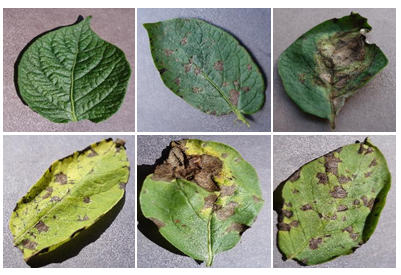
Fig.1 Dataset
C. Feature Extraction
After de-noising images, we need to remove this feature. A feature was used to reduce image size without sacrificing important details. It also removes unnecessary functions.
D. Classification
Any classification algorithm or deep neural network such as ANN, CNN or SVM can be used to classify an image into a specific object class. Compared to other algorithms, CNN is the neural network used for image classification because it has the highest accuracy.
E. Model Building
Convolutional Neural Networks (CNNs) represent a significant advancement in image recognition technology, specifically tailored for processing visual information. Unlike traditional neural networks, CNNs operate in two dimensions, aligning well with the nature of image data. The key innovation lies in the convolutional layer, where filters are applied to input images, capturing distinctive features before constructing a feature map that encapsulates the identified patterns. During training, CNNs learn these filters in the context of the given prediction problem. CNNs excel in image classification tasks by leveraging convolutional operations, non-linear activation functions, and spatial downsampling to efficiently process and extract hierarchical features from visual data. The resultant architecture enables robust image analysis and has become a standard approach in computer vision applications.
The architecture of a CNN typically consists of three main layers:
- Convolutional layer : This layer applies filters to the input images, extracting meaningful features.
- ReLU (Rectified linear unit) layer : After convolution, the Rectified Linear Unit introduces non- linearity to the model by applying the rectified linear activation function, enhancing the network's ability to capture complex patterns.
- Pooling Layer: This layer down samples the spatial dimensions of the feature map, reducing computational complexity and retaining essential information.
- Pair of fully-connected(FC) layers: This further process the extracted features and contribute to the final classification or output of the Convolutional Neural Network (CNN).
The main computations take place in the Convolution (Conv) layer, where these layers act as feature extractors, identifying characteristics in the input image and generating the feature map. This layer utilizes a kernel based on image characteristics to perform convolution operations, with the goal of extracting image features through the use of kernels, pooling layers, and the Rectified Linear Unit (ReLU) activation.
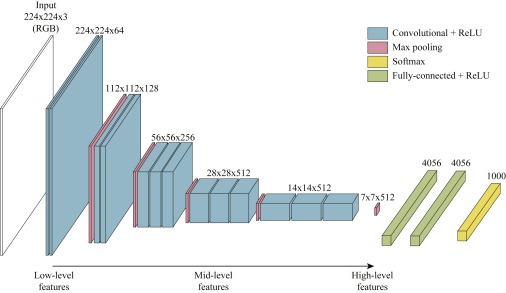
Fig. 2 Architecture of Convolutional Neural Network
ReLU Layer: The Rels layer, also known as Relu, is a type of activation layer that works in a specific way.
The non-linearity is introduced by the ReLU operation, applied after the completion of the convolution process. Negative values are converted to 0 by the ReLU layer, expediting the training process.
The pooling layer, which shares neuron weights in feature maps, reduces the spatial resolution of feature maps. It can employ various pooling techniques, including average pooling, maximum pooling, multi-resolution order-less pooling, and stochastic pooling.
Flatten Layer: This layer converts a two-dimensional dataset into a single feature vector.
Fully Connected Layer: Neurons in this layer are intricately linked to those in preceding layers. The fully connected layer uses the soft max technique to interpret an input image using a feature vector. Back propagation is employed to minimize the error value in this layer.
The operational process of CNN in plant leaf detection categorization is illustrated in Figure 3. It takes a 2D vector representation of an image as input and performs the described operations before classifying the image.
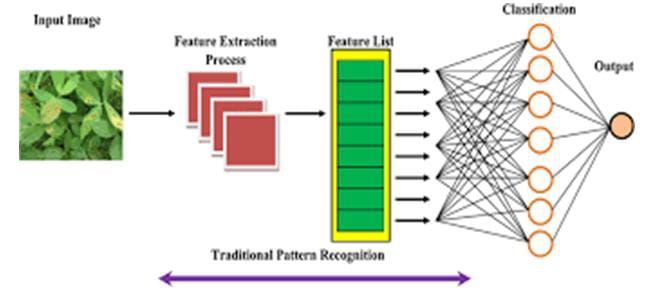
Fig. 3: CNN Illustration in Plant Leaf Detection
The diagram provided illustrates the various stages involved in image classification.
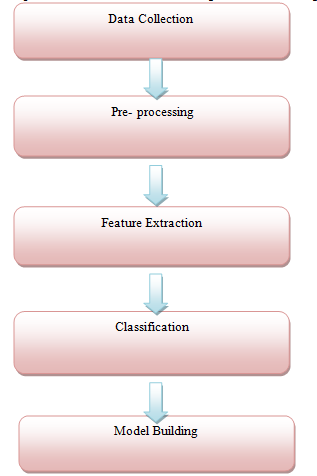
Fig 4: Some basic algorithm for Image Classification
IV. RESULT AND ANALYSIS
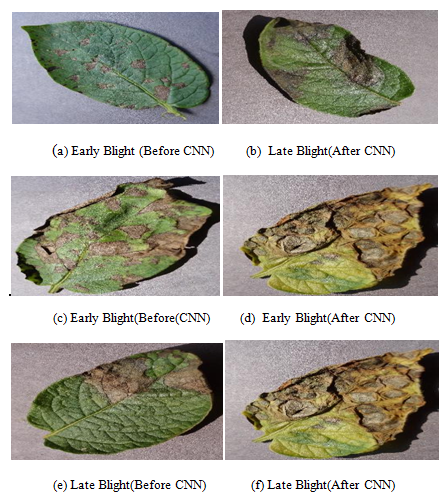
TABLE 2
Model Performance Comparison
|
MODEL
|
DATASET
|
ACCURACY(%)
|
PROCESSING TIME (MS)
|
ERROR PERCENTAGE(%)
|
|
Convolutional Neural Network
|
MNIST
|
99.9
|
100
|
0.3
|
|
K -Nearest Neighbors
|
Iris
|
96
|
1
|
4
|
|
Back-propagation Neural Network
|
Fashion-MNIST
|
92
|
50
|
8
|
|
Naive -Bayes
|
Spambase
|
90
|
0.1
|
10
|
|
Support-Vector Machine |
Wine
|
90
|
10
|
10
|
|
Decision Trees
|
Banknote auther
|
94
|
100
|
100
|
|
Random Forests |
Breast cancer |
97 |
97 |
500 |
|
Ada Boost |
Mushroom Class |
99 |
99 |
1000 |
Comparision of Different model with its Accuracy
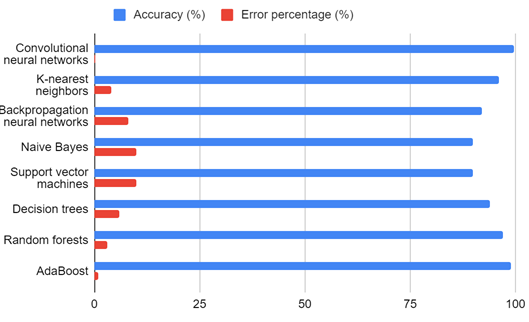
Fig. 5 Accuracy and Error Percentage Graph
Conclusion
Our end-to-end neural network system demonstrates proficiency in classifying leaf images, distinguishing between healthy leaves and those affected by infections. The model incorporates a convolutional neural network (CNN) encoder-decoder, specifically designed to enhance leaf image classification. This publication synthesizes insights from various studies utilizing deep neural networks to identify diseases in potato leaves, particularly Early Blight disease and Late Blight disease. Comparative analysis among different deep neural networks revealed that CNN outperformed others in accuracy when detecting and classifying diseases in potato leaves, including early blight disease, late blight disease, and non-infected leaves. According to the study, Artificial Neural Networks (ANN) achieved an accuracy of 85 percent, Support Vector Machines (SVM) scored 88.89 percent accuracy, while CNN [3] exhibited an impressive accuracy of 99.07 percent. This underscores the finding that Convolutional Neural Networks offer the highest level of precision. In the realm of Deep Learning, CNNs represent a relatively recent technology effectively utilized for image recognition and discerning distinctive features.
References
[1] Pitchai R1, Sharath Kumar G2, Ashutosh Verma D3, Madhu Babu CH4,\"Potato Plant Disease detection using Convolutional Neural Network\",[2020] [2] Gautam Trivedi, Ankur Yaduvanshi, M.Heema,\"Identification of Disease in Plants using Deep Learning\",[2019] [3] Mr. Girish Athanikar, Ms. Priti Badar , \"Potato leaf disease Detection and Classificaion System\",[2016] [4] Tushar H Jaware , Ravindra D Badgujar, Prashant G Patil, \"Crop Disease Detection using image Segmentation\",[2012] [5] Mr. Viraj A. Gulhane, Dr. Ajay A. Gurjar, \"Detection of Disease on Cotton Leaves and its Possible Diagnosis\",[2011] [6] Anjna, Meenakshi Sood, Pradeep Kumar Singh, \"Hybrid System for Detection and Classification of Plant disease Using Quaitative texture Features Analysis\"[2020] [7] Rizqi Amaliatus Sholihati, Indra Adji Sulistijono, Anhar Risnumawan, Eny Kusumawati, \" Potato Leaf Classification Using Deep Learning Approach\",[2020] [8] C.U. kumari, S. Jeevan Prasad , G. Mounika ,\" Leaf Disease Detection : Feature Extraction With K- means Clustering and Classification with ANN\",[2019] [9] R. Mounika, Dr. P. Shayamala Bharathi ,\"Detection of Plants Using Deep Learning\",[2019] [10] Divyansh Tiwari, Mritunjay Ashish, Nitish Gangwar, Abhishek Sharma, Suhanshu Patel, Dr. Suyash Bharadwaj, \"Potato Plant Diseases Detection Using Deep Learning \".[2020] [11] N, K. et al. (2021) ‘Rice leaf diseases prediction using deep neural networks with transfer learning’, Environmental Research [Preprint]. Available at: https://doi.org/10.1016/j.envres.2021.111275. [12] Sengupta, S. and Das, A.K. (2017) ‘Particle Swarm Optimization based incremental classifier design for rice disease prediction’, Computers and Electronics in Agriculture [Preprint]. Available at: https://doi.org/10.1016/j.compag.2017.06.024. [13] Ahmed, S.T. et al. (2024) ‘Enhancing Precision in Rice Leaf Disease Detection: A Transformer Model Approach with Attention Mapping’, in 2024 International Conference on Advances in Computing, Communication, Electrical, and Smart Systems (iCACCESS), pp. 1–6. Available at: https://doi.org/10.1109/iCACCESS61735.2024.10499500. [14] Yadav, A. et al. (2024) ‘Evaluation and Categorisation of Hispa Rice Disease Severity Levels Using CNN-RF Model’, in 2024 International Conference on Automation and Computation (AUTOCOM), pp. 33–37. Available at :https://doi.org/10.1109/AUTOCOM60220.2024.10486095. [15] Amara, J., Bouaziz, B. and Algergawy, A. (2017) ‘A deep learning-based approach for banana leaf diseases classification’, in Lecture Notes in Informatics (LNI), Proceedings - Series of the Gesellschaft fur Informatik (GI). [16] Andrianto, H. et al. (2020) ‘Smartphone application for deep learning-based rice plant disease detection’, in 2020 International Conference on InformationTechnology Systems and Innovation, ICITSI 2020 - Proceedings. Available at: https://doi.org/10.1109/ICITSI50517.2020.9264942. [17] Aziz, F. et al. (2023) ‘YOLO Network-Based for Detection of Rice Leaf Disease’, in 2023 International Conference on Information Technology Research and Innovation, ICITRI 2023. Available at: https://doi.org/10.1109/ICITRI59340.2023.10249843. [18] Agnihotri, S. et al. (2023) ‘Comparative Analysis of Tomato Leaf Disease Detection Using Machine Learning’, in 2023 6th International Conference on Information Systems and Computer Networks, ISCON 2023. Available at: https://doi.org/10.1109/ISCON57294.2023.10112092. [19] Ahmed, K. et al. (2019) ‘Rice leaf disease detection using machine learning techniques’, in 2019 International Conference on Sustainable Technologies for Industry 4.0, STI 2019. Available at: https://doi.org/10.1109/STI47673.2019.9068096. [20] Ahmed, S.T. et al. (2024) ‘Enhancing Precision in Rice Leaf Disease Detection: A Transformer Model Approach with Attention Mapping’, in 2024 International Conference on Advances in Computing, Communication, Electrical, and Smart Systems (iCACCESS), pp. 1–6. Available at: https://doi.org/10.1109/iCACCESS61735.2024.10499500.
Copyright
Copyright © 2024 Niharika Sharma, Jaimala Jha. This is an open access article distributed under the Creative Commons Attribution License, which permits unrestricted use, distribution, and reproduction in any medium, provided the original work is properly cited.

Download Paper
Paper Id : IJRASET65633
Publish Date : 2024-11-28
ISSN : 2321-9653
Publisher Name : IJRASET
DOI Link : Click Here
 Submit Paper Online
Submit Paper Online

